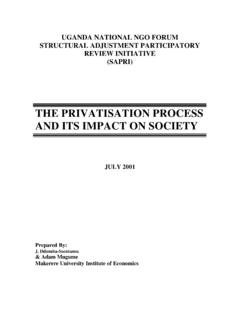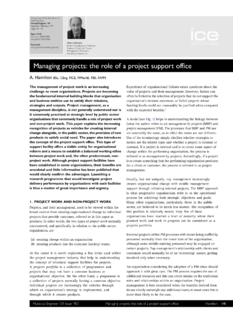Transcription of The Labour Market And Economic Development …
1 ZIMBABWE CONGRESS OF TRADE UNIONS (ZCTU) The Labour Market And Economic Development 1980-2000 Paper by: Chiripanhura T. Makwavarara 1 Labour Market AND Economic Development , 1991-2000. 1. Introduction The problems of unemployment and underemployment are evident in most African economies. The structure of the economies is fundamentally entrenched in dualism and enclavity. At independence in 1980, Zimbabwe inherited an economy that exhibited both extreme characteristics of a relatively developed economy and Economic backwardness and neglect of the majority of the people.
2 This dualism (separate Development ) had arisen from the policy of white supremacy that underlined the colonial era. The relative strength of the economy lay in its diversified formal sector, with no overwhelmingly dominant sector. Industry had developed to the extent that by 1980, the manufacturing sector consisted of some 1,260 separate units producing 7,000 different products. In fact, by the advent of independence, the manufacturing sector was already contributing the most (25%) to GDP, as well as to employment (18%). The formal Labour Market was also segmented such that while the workers in the private sector were governed by the Industrial Conciliation Act, those in government service were under the Public Service Act, while local authorities were governed under the Urban Council's Act.
3 The economy before independence was characterised by racial inequalities. Access to resources and social services was done along racial lines, with the minority whites getting the lion's share. They had the monopoly to white collar jobs. One clear effect of racial inequalities is captured in Table 1, which traces the inherited wage structure in Zimbabwe. Table 1: Ratio of European to African Wages, 1981 Sector Professional & technical (Males) Clerical (Males) Skilled (Males) Semi-skilled (Males) Overall (Persons) Agriculture Manufacturing 4 Finance - Public 7 All Sectors Source: World Bank:1987, Annex 1, Table 6: 25 Table 1 suggests that the ratio of European to African wages was highest in the sectors with the highest proportion of unskilled workers (agriculture) where the ratio was a high as 25:1 and lowest in the skilled sectors (financial services) with a ratio of 4:1.
4 Skewed access to means of production, namely land, skills, entrepreneurship and capital created a highly inequitable distribution of income, as suggested in Table 2. 2 Table 2: Distribution of Income By Race, 1982 Group Proportion of Population (%) Share in Wages/Salaries (%) African 60 European 2 37 Coloureds 2 Asians 1 Source: National Manpower Survey, ,1981 Table 2 shows that, whereas blacks constituted close to 98% of the population, they accounted for a disproportionate 60% of income. At the other extreme, whites who constituted 2% of the population received 37% of the total income in 1981.
5 As Harris (1977) aptly observes, "..white capitalists and landowners receive satisfactory profits, and white workers satisfactory wages. The returns are secured out of the relative deprivation of black industrial workers and peasants." Given the highly inequitable distribution of resources and opportunities during the colonial era, the post-independence government intervened extensively in the Labour Market to correct these distortions. Government intervention was premised on the observation that, at independence the unions were fragmented and weak. In 1980, there were as many as 6 national trade union centres, with most of them associated with some political party.
6 The ruling party, ZANU (PF) did not have strong trade union connections, and hence the tendency by government to be suspicious of trade unions and to be paternalistic in its approach to them. At the advent of independence in 1980 in Zimbabwe, another central concern of government was that of addressing the inherited inequalities of the past in human resource Development . The majority of black children did not have access to education and training. The major weakness of the Rhodesian VET system is that it was preoccupied with racial exclusion by a predominantly white industry. The VET system that was established after independence was centrally controlled to ensure that blacks had access to it and to address the skill drain that occurred after independence.
7 Through the Manpower Planning and Development Act of 1984, all issues of human resource Development were centralised through the repeal of the Vocational Education and Training Act of 1978 and the Apprenticeship Training and Skilled Manpower Development Act of 1968. The Vocational Education and Training Act of 1978 had created the Manpower Development and Training Authority (MANDATA), which at independence was given authority over apprenticeship training, which in the past had its own autonomy under the Apprenticeship Training and Skilled Manpower Development Act of 1968. In summary, the Manpower Planning and Development Act of 1984 replaced MANDATA with the National Manpower Advisory Council (NAMACO), it provided for the establishment of government VET institutions, registration of private training institutions and established the Zimbabwe Manpower Development Fund (ZIMDEF).
8 According to the Act, NAMACO was established primarily to advise the Minister responsible for manpower Development on matters concerning the Development of the nation s manpower. The mandate given to NAMACO under the Act is very broad, covering issues such as the establishment of new schemes for manpower Development , advising the Minister on ways to improve existing training programmes, including the introduction of new courses, course content, suggestions on on-the-job apprenticeship among others. In addition to establishing the NAMACO Council that is tripartite, sectoral advisory committees (there are at present 16) made up of employer and employee representatives were also created to enable NAMACO to advise on industry specific requirements.
9 The Act also provides for the recruitment and assignment of apprentices to employers, regulates apprenticeship training among other functions. Clearly, therefore, the Act centralised most of these functions and vested the powers in the Minister. By so doing, the Act effectively created a highly centralised, bureaucratic and inflexible system that focussed narrowly on serving the formal sector. As Munetsi (1993) observed, ..academic considerations were substituted for racial considerations, as TVE was generally restricted to formal qualifications, in terms of both entry 3requirements and final qualifications, (1993: 84).
10 1 In this regard, it became difficult for other areas, especially the non-formal sector to be catered for. This runs in the face of government policy, which sought to promote activities in the non-formal sector in order to alleviate the unemployment problem. The centralised recruitment of apprentices was such that prospective apprentices had to apply to the Registrar of Apprenticeship at the Ministry of After the initial selection, at least twice as many candidates as there were places were sent to interested employers. This centralised system was meant to make the opportunity for apprenticeship training more universal, to stop racist practices and was in line with socialist planning.










